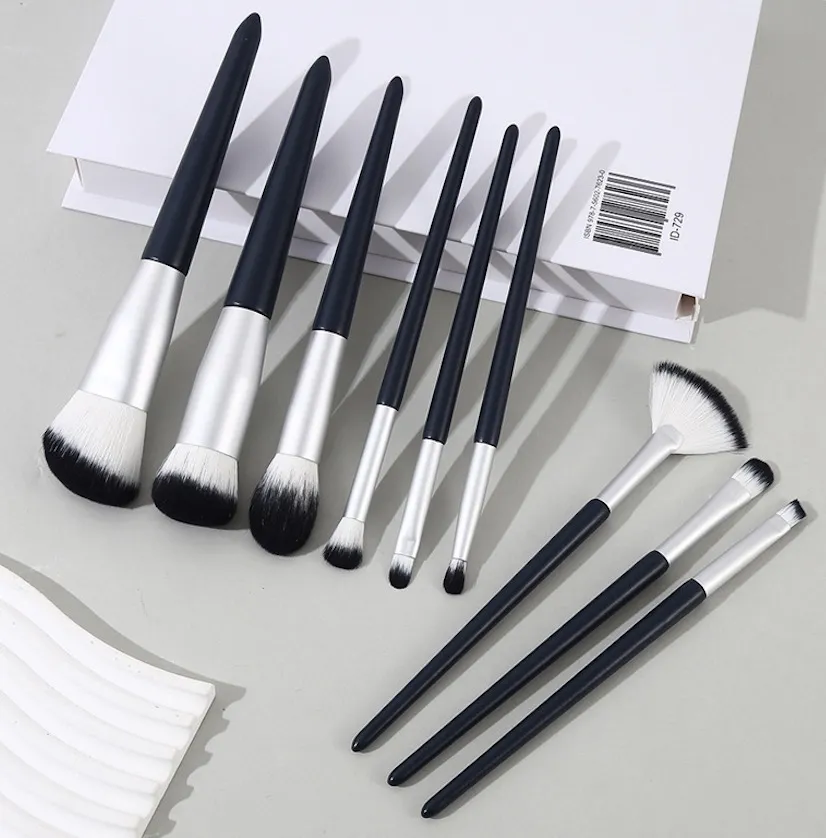Choosing the wrong brush can irritate skin and ruin a perfect application. This leads to unhappy customers and damages your brand’s credibility. Specifying brushes based on skin type is the solution.
To choose the right makeup brush, match the fiber to the skin type. Use dense, synthetic kabuki brushes for oily skin; soft, fluffy fibers for dry skin; and hypoallergenic1, rounded synthetics for sensitive skin. Clean brushes weekly to reduce bacterial buildup.
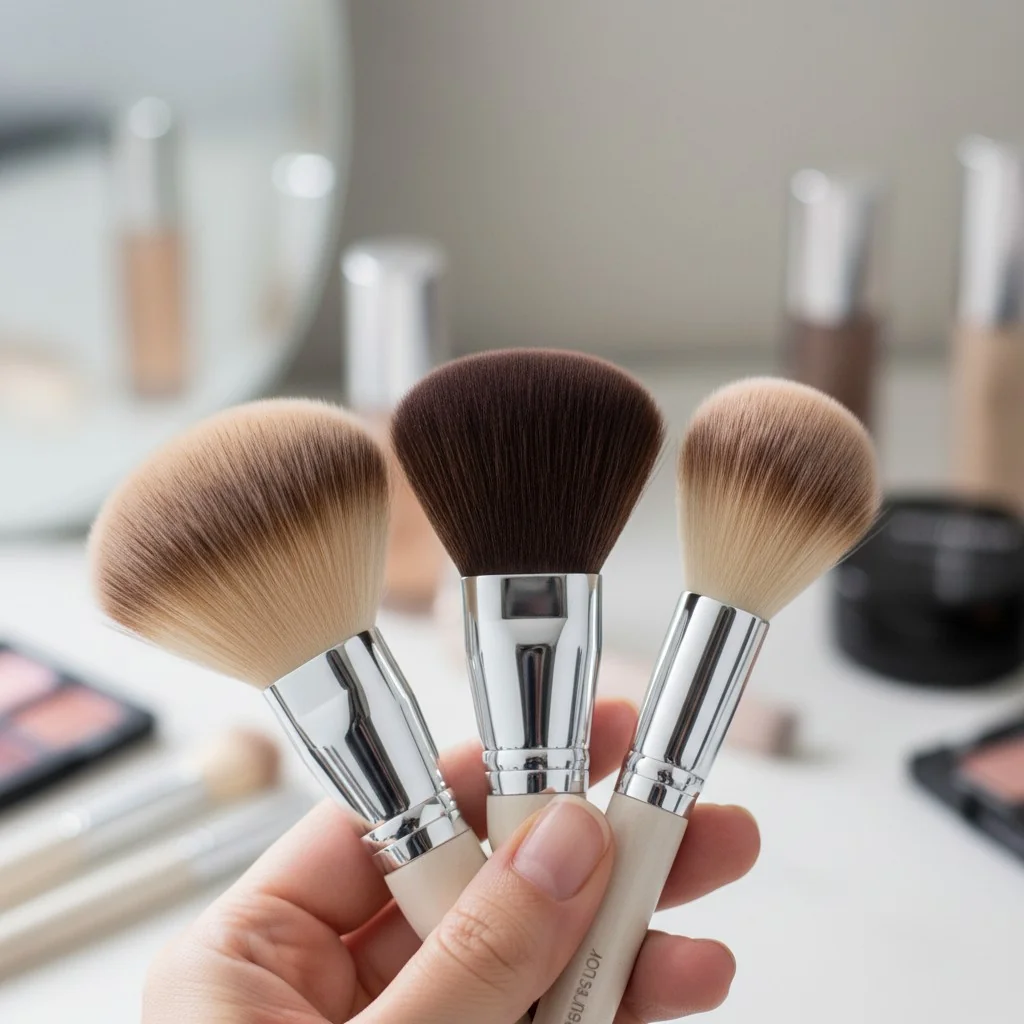
Getting this right is not just about a better makeup application. It’s about building trust with your customers. When your tools perform exactly as promised for their specific skin concerns, you create brand loyalty. As a brush manufacturer, I’ve seen firsthand how these small details make a huge difference. Let’s break down exactly what you need to know to spec the perfect brush line for your brand.
Synthetic brushes are better for acne-prone skin because their non-porous fibers absorb less oil and are easier to clean.True
Studies show natural hair is more porous and can trap more oil, bacteria, and product, potentially contributing to breakouts if not cleaned meticulously. Synthetics offer a more hygienic surface.
Natural hair brushes are always better for applying powder makeup.False
While traditional natural hairs have cuticles that pick up powder well, modern synthetic fibers are now engineered with micro-tapers and crimps that mimic this ability, offering comparable powder pickup with superior hygiene and durability.
Fiber-to-Skin Match: What is the quickest way to spec the right brush for different skin types?
A single brush type can’t serve every customer. Using the wrong fiber can cause breakouts for one person and flaky patches for another. This inconsistency leads to poor reviews and returns.
The solution is to match the brush fiber directly to the user’s skin needs. For oily skin, spec dense synthetics. For dry skin, choose soft, fluffy fibers. For sensitive skin, demand hypoallergenic synthetics with smooth, rounded tips. This targeted approach ensures performance and customer satisfaction.
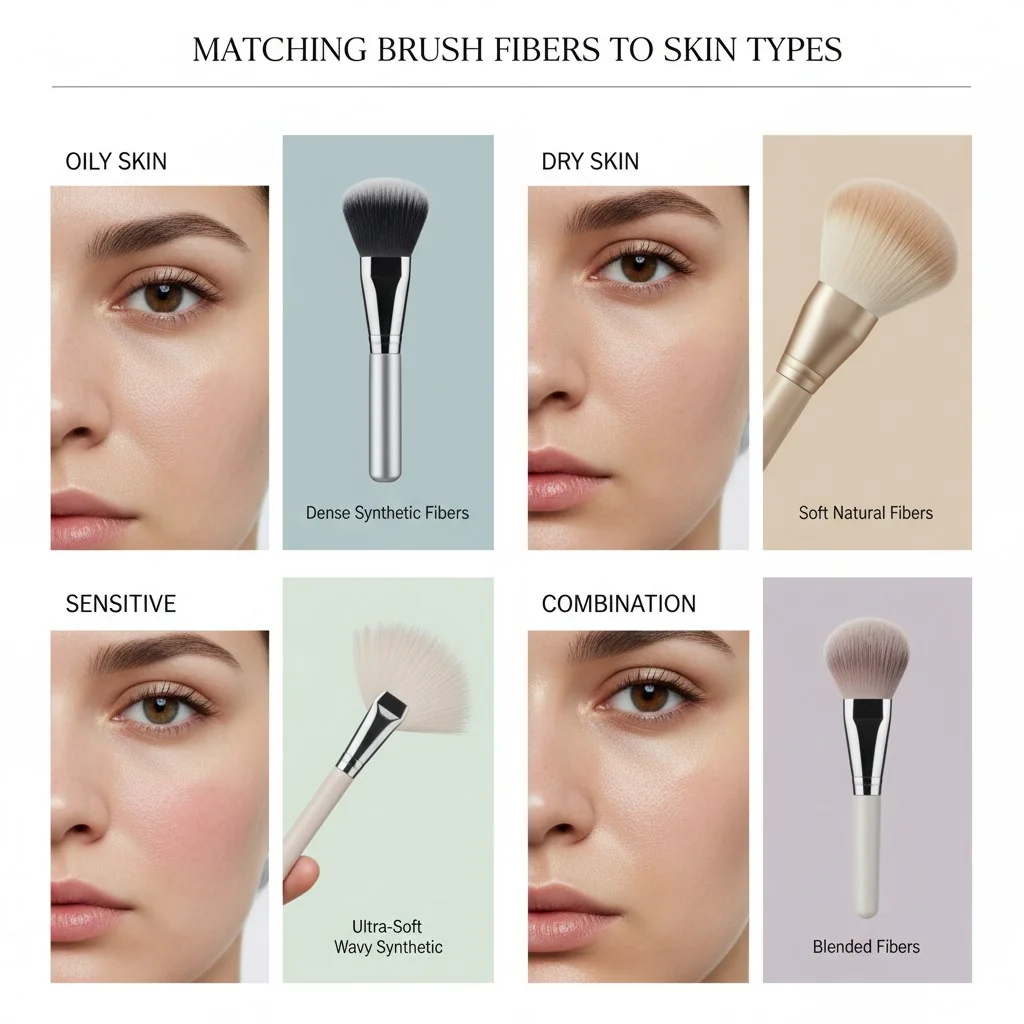
When I work with brand founders, the first thing we discuss is their target customer’s skin profile. It’s the foundation of a successful tool. A brush isn’t just an applicator; it’s a skincare-adjacent product. The texture of the fibers and how they interact with the skin’s surface can either enhance or detract from the makeup’s performance. For example, a scratchy, poorly made brush can cause micro-abrasions, leading to redness and irritation, especially on sensitive skin. That’s why a thoughtful fiber-to-skin match2 is a non-negotiable part of the OEM specification process. It shows your customer you understand their needs on a deeper level.
Matching Fibers to Skin Concerns
| Skin Type | Recommended Brush | Why It Works | Best Paired With |
|---|---|---|---|
| Oily / Acne-Prone | Dense synthetic (PBT/Taklon), flat-top or kabuki. | Non-porous fibers don’t absorb oil. Dense structure buffs product in without streaking. Easier to clean, reducing bacterial retention. | Liquids, creams. |
| Dry / Flaky | Ultra-soft, fluffy synthetic (mimicking natural hair). Duo-fiber. | Gentle fibers glide over skin without lifting dry patches or texture. A light touch deposits product evenly. | Powders, stippling liquids. |
| Sensitive / Rosacea | Hypoallergenic, dye-stable synthetic with a rounded profile. | Soft, rounded tips prevent poking or irritation. Low-shed design and smooth ferrules minimize potential allergens and friction. | Mineral powders, serums. |
| Combination | A zone-specific set. | Allows for targeted application: a dense brush for the oily T-zone and a fluffy brush for drier cheeks. A small precision brush for concealing. | A mix of liquids and powders. |
All synthetic brushes are hypoallergenic.False
While many synthetics like PBT are less likely to cause allergies than natural hair, some can be treated with dyes or chemicals that may irritate sensitive skin. True hypoallergenic claims require testing and dye-stability verification.
A 2025 study found that 44.3% of makeup brush users rarely cleaned their tools.True
The study highlighted a significant gap between awareness of hygiene risks and actual cleaning behavior, reinforcing the need for brands to educate consumers on proper brush care.
Brush Anatomy That Matters: How do density, taper, and shape affect real skin outcomes?
You’ve approved a beautiful brush sample, but the bulk order yields poor reviews. Customers complain about streaky foundation or patchy powder. The problem is that visual appeal doesn’t guarantee performance.
The solution lies in specifying the brush’s anatomy: its density, taper, and shape. These three elements dictate how the brush picks up, deposits, and blends makeup. Understanding them is key to creating a tool that delivers a flawless finish every time.
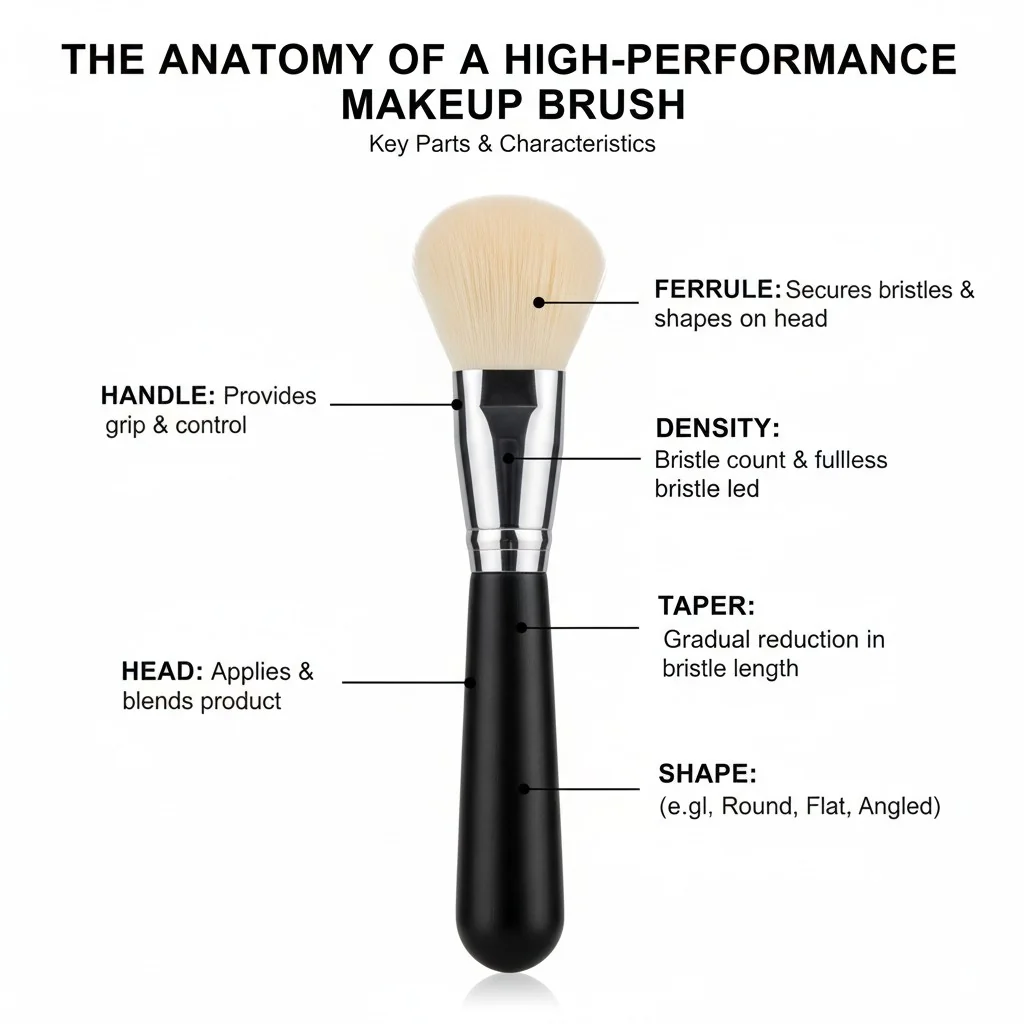
On the factory floor, I learned that a millimeter of difference in fiber length or a slight change in how a ferrule is crimped can completely alter a brush’s performance. It’s a science. When you’re writing your OEM spec sheet, being precise about these details is what separates an average brush from a professional-grade tool. It protects your investment and ensures the final product matches your vision and your customers’ expectations. Let’s look at the three core components you need to define.
Density: Controlling Coverage
Density refers to how many fibers are packed into the ferrule.
- High Density: More fibers create a firm surface. This is ideal for buffing in liquid or cream foundation for full coverage, especially on oily skin where you want to press product into the skin.
- Low Density: Fewer fibers create a soft, flexible head. This is perfect for a light dusting of setting powder or a sheer wash of blush, especially on dry skin where you want to avoid disturbing texture.
Taper/Tip: Ensuring a Gentle Touch
The tip of the brush is what makes the most contact with the skin.
- Tapered/Rounded Tips: Fibers that are finely tapered to a point or bundled into a soft dome reduce the "pokey" feeling that can irritate sensitive areas like the under-eyes. This design minimizes the risk of micro-abrasions.
Shape: Defining the Application
The overall shape of the brush head is designed for a specific task.
- Flat-Top: Provides a flat surface for buffing and stippling foundation.
- Dome: The classic fluffy shape for sweeping on powders.
- Angled: Follows the contours of the face for applying blush or contour without dragging.
- Duo-Fiber: Mixes long, sparse fibers with a dense base to create an airbrushed, skin-like finish.
Densely packed brushes are always harsh on the skin.False
Density provides firmness for blending, but harshness comes from untapered, coarse fibers. A dense brush made with ultra-soft, finely tapered synthetic fibers can feel soft while providing excellent coverage.
Rounded brush tips can help reduce micro-abrasions on the skin.True
Sharp or flat-cut fiber tips can scratch or poke the skin's surface. A rounded or tapered profile allows the brush to glide more smoothly, which is especially important for sensitive skin or the delicate eye area.
Hygiene, QC, and Claims: What should you require (and prove) in your OEM spec?
Your brand claims its brushes are "vegan" and "hypoallergenic," but you have no documentation to back it up. A savvy customer questions your claims, and your brand’s integrity is at risk.
To avoid this, you must build your OEM specification around provable quality control and hygiene standards. This means demanding material data sheets, test reports for claims, and using materials that support good hygiene.

This is one of the biggest pain points I hear from brand founders. They are sold a promise by a factory, but when it’s time to show proof, the communication stops. A reliable manufacturing partner should be able to provide documentation for their materials and claims. A recent study found that common bacteria like Staphylococcus are prevalent on used makeup brushes, with 27.8% of users reporting skin issues. This data is powerful. It gives you a clear reason to spec non-porous materials and educate your customers on cleaning, which in turn positions your brand as a responsible expert.
Key OEM Specification Requirements
1. Cleaning Cadence and User Education
Your marketing should guide users based on scientific evidence.
- General Use: Recommend weekly cleaning for all face brushes.
- Sensitive/Acne-Prone Skin: Advise cleaning 2x per week to minimize bacterial transfer.
- Why: Cite studies showing the presence of Staphylococcus and Micrococcus on brushes to underscore the importance of this routine. Always instruct users to air-dry brushes horizontally to prevent water from loosening the glue in the ferrule.
2. Material Specifications
- Fibers: Choose non-porous synthetic fibers (PBT, Taklon) that are less likely to harbor bacteria and are easier to clean.
- Ferrules: Opt for smooth, corrosion-resistant ferrules (like aluminum or copper) with no gaps where bacteria can hide.
- Glues: Require high-quality, solvent-stable glues that won’t degrade with regular cleaning, preventing shedding and potential skin irritation.
3. Claims Validation
Never take claims at face value.
- Hypoallergenic/Nickel-Controlled: Request test reports to prove these claims.
- Cruelty-Free/Vegan: Ask for certifications from the fiber supplier. This proves no animal products were used and no animal testing occurred.
- "Antibacterial" Brushes: Be skeptical. This claim is only valid if the fibers or ferrule have a tested antimicrobial coating. Otherwise, it’s just marketing. Focus on the hygienic benefits of non-porous synthetics and proper cleaning instead.
Cleaning makeup brushes once a month is sufficient for most users.False
Studies show significant bacterial growth, including Staphylococcus, within a week of use. For face brushes, weekly cleaning is the recommended minimum, with more frequent cleaning for those with sensitive or acne-prone skin.
Brushes marketed as 'antibacterial' are always effective at killing germs.False
This claim is only meaningful if the brush has been treated with a proven antimicrobial coating and has undergone testing to validate its efficacy. Without testing, the claim is unsubstantiated marketing.
Trending Buyer Preferences: What current buyer preferences are shaping global demand for makeup brushes?
Your brush collection is high-quality, but sales are flat. The market seems to be moving in a direction you haven’t anticipated. You’re missing out on a large and growing customer segment.
The solution is to align your product development with powerful consumer trends. Today’s buyers demand vegan and cruelty-free products with sustainable attributes. Tapping into this movement is essential for growth.
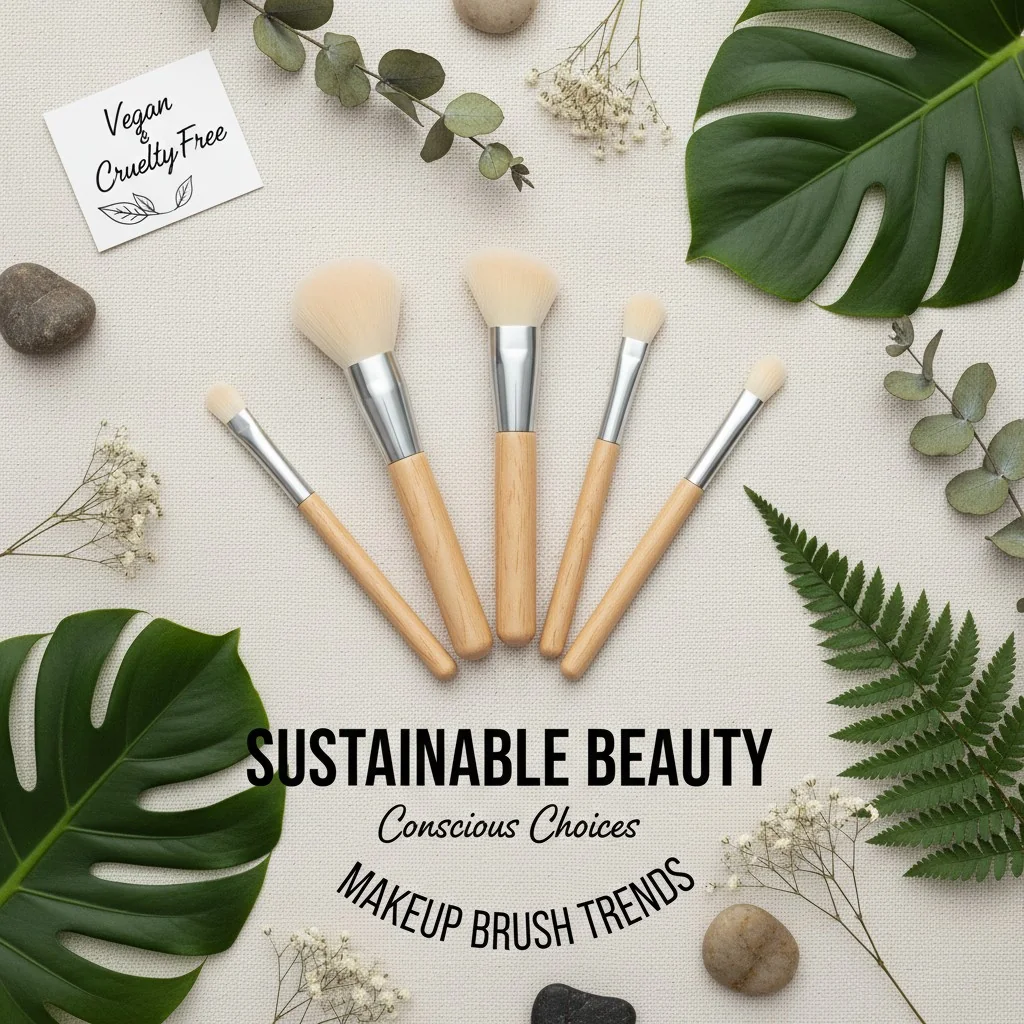
The numbers speak for themselves. The global vegan cosmetics market was valued at nearly $13 billion in 2021 and is projected to grow at a steady 6.3% CAGR through 2030. This isn’t a niche trend; it’s a major market shift. In the UK, synthetic brushes3 already hold a 58% market share, and consumer preference for them is a staggering 78%. As a brand founder, you can’t afford to ignore this. I always advise my clients to build their collections around PBT/Taklon fibers and explore sustainable handle options. It aligns the brand with modern values, which is a powerful purchasing driver for today’s consumers.
Aligning Your Brand with Market Trends
The Demand for Vegan and Synthetic
The shift away from natural animal hair is driven by two things: ethics and performance. Consumers are more aware than ever of animal welfare, and the "cruelty-free" claim is a major decision factor. At the same time, modern synthetic fibers have evolved. They are no longer the stiff, streaky plastics of the past. High-grade Taklon and PBT fibers are now engineered to be incredibly soft, durable, and excellent at picking up both powders and creams. This combination of ethical alignment and superior performance is why synthetics are dominating the market.
The Growth of Sustainability
Beyond being vegan, customers are looking for sustainable materials4 throughout the product. This is a huge opportunity for brand differentiation.
- Handles: Instead of standard wood or plastic, consider options like Forest Stewardship Council (FSC) certified wood, which guarantees responsible forest management. Recycled aluminum or bamboo are also excellent, eco-conscious choices.
- Packaging: Move away from single-use plastics and toward recyclable or reusable options like cotton pouches or paper-based boxes.
By embedding these preferences into your product DNA, you’re not just selling a makeup brush. You’re selling a value system that resonates deeply with a growing global audience.
The global market for vegan cosmetics is shrinking.False
The global vegan cosmetics market was valued at USD 12.9 billion in 2021 and is projected to grow at a compound annual growth rate (CAGR) of approximately 6.3% from 2022 to 2030.
Consumer preference for synthetic makeup brushes is now over 75% in some key markets.True
In the UK, for example, consumer preference for synthetic brushes reached 78% in 2024, reflecting a strong market demand for performance and ethical, cruelty-free products.
Conclusion
Choosing the right brush means matching fibers to skin, defining its anatomy, verifying quality, and aligning with modern values. This builds a brand that customers will trust and love.
References
-
Understanding hypoallergenic products is crucial for sensitive skin users; learn how to choose the right brushes. ↩
-
Learn the science behind matching brush fibers to skin types for optimal makeup application. ↩
-
Explore how synthetic brushes can enhance makeup application and hygiene, making them ideal for various skin types. ↩
-
Discover eco-friendly materials that can differentiate your makeup brush brand in the market. ↩


